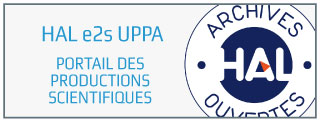
|
Des remarques, des corrections ou des questions ? Contactez-nous ::: hal@univ-pau.fr ::: (Gaëlle, Marina, Julien) ::: HALathon, mode d'emploi ::: |

| # | Type | Année | Titre | doi | Notice HAL | accès HAL | label OA |
|---|---|---|---|---|---|---|---|
| 1 | ART | 2020 | Microbial Communities and Sulfate-Reducing Microorganisms Abundance and Diversity in Municipal Anaerobic Sewage Sludge Digesters from a Wastewater Treatment Plant (Marrakech, Morocco) | 10.3390/pr8101284 | hal-02985369 | fichier | openaccess |
| 2 | ART | 2020 | Relationship Between Hg Speciation and Hg Methylation/Demethylation Processes in the Sulfate-Reducing Bacterium Pseudodesulfovibrio hydrargyri: Evidences From HERFD-XANES and Nano-XRF | 10.3389/fmicb.2020.584715 | hal-02995211 | fichier | openaccess |
| 3 | ART | 2020 | Genome insights of mercury methylation among Desulfovibrio and Pseudodesulfovibrio strains | 10.1016/j.resmic.2019.10.003 | hal-02390352 |
label OA |
openaccess |
| 4 | ART | 2020 | Meta-omics Provides Insights into the Impact of Hydrocarbon Contamination on Microbial Mat Functioning | 10.1007/s00248-020-01493-x | hal-03065790 | fichier | openaccess |
| 5 | ART | 2019 | Extreme Arsenic Bioaccumulation Factor Variability in Lake Titicaca, Bolivia | 10.1038/s41598-019-47183-8 | hal-02339758 | fichier | openaccess |
| 6 | ART | 2018 | Pseudodesulfovibrio hydrargyri sp. nov., a mercury-methylating bacterium isolated from a brackish sediment | 10.1099/ijsem.0.002173 | hal-01836962 |
label OA |
openaccess |
| 7 | ART | 2017 | Unraveling the environmental and anthropogenic drivers of bacterial community changes in the Estuary of Bilbao and its tributaries | 10.1371/journal.pone.0178755 | hal-01563521 | fichier | openaccess |
| 8 | ART | 2017 | Distribution of Sulfate-Reducing Communities from Estuarine to Marine Bay Waters | 10.1007/s00248-016-0842-5 | hal-01499135 | fichier | openaccess |
| 9 | ART | 2017 | Draft Genome Sequence of Desulfovibrio BerOc1, a Mercury-Methylating Strain | 10.1128/genomeA.01483-16 | hal-01481298 | fichier | openaccess |
| 10 | ART | 2016 | Diurnal variability and biogeochemical reactivity of mercury species in an extreme high-altitude lake ecosystem of the Bolivian Altiplano | 10.1007/s11356-015-5917-1 | hal-01439880 | fichier | openaccess |
| 11 | ART | 2014 | Benthic foraminifera from the deep-water Niger delta (Gulf of Guinea): Assessing present-day and past activity of hydrate pockmarks | 10.1016/j.dsr.2014.08.011 | hal-01631883 |
label OA |
openaccess |
| 12 | ART | 2013 | Combination of high throughput cultivation and dsrA sequencing for assessment of sulfate-reducing bacteria diversity in sediments | 10.1111/j.1574-6941.2012.01452.x | hal-01546606 |
label OA |
openaccess |
| 13 | ART | 2013 | Three-year survey of sulfate-reducing bacteria community structure in Carnoulès acid mine drainage (France), highly contaminated by arsenic | 10.1111/1574-6941.12028 | hal-01631885 |
label OA |
openaccess |
| 14 | ART | 2012 | Ring-hydroxylating dioxygenase (RHD) expression in a microbial community during the early response to oil pollution | 10.1111/j.1574-6941.2011.01270.x | hal-01631886 |
label OA |
openaccess |
| 15 | ART | 2012 | Central role of dynamic tidal biofilms dominated by aerobic hydrocarbonoclastic bacteria and diatoms in the biodegradation of hydrocarbons in coastal mudflats | 10.1128/AEM.00072-12 | hal-01631887 |
label OA |
openaccess |
| 16 | ART | 2011 | Are alkane hydroxylase genes (alkB) relevant to assess petroleum bioremediation processes in chronically polluted coastal sediments? | 10.1007/s00253-011-3381-5 | hal-01631889 |
label OA |
openaccess |
| 17 | ART | 2010 | Hexavalent chromium reduction by bacterial consortia and pure strains from an alkaline industrial effluent | 10.1111/j.1365-2672.2010.04849.x | hal-01631892 |
label OA |
openaccess |
| 18 | ART | 2010 | Nested PCR and new primers for analysis of sulfate-reducing bacteria in low-cell-biomass environments | 10.1128/AEM.02023-09 | hal-01631891 |
label OA |
openaccess |
| 19 | ART | 2008 | Structure of bacterial communities along a hydrocarbon contamination gradient in a coastal sediment | 10.1111/j.1574-6941.2008.00589.x | hal-01631900 |
label OA |
openaccess |
| 20 | ART | 2007 | Bacterial community structure along the Adour estuary (French Atlantic coast): Influence of salinity gradient versus metal contamination | 10.3354/ame01128 | hal-01590331 |
label OA |
openaccess |
| 21 | ART | 2007 | Effects of heavy fuel oil on the bacterial community structure of a pristine microbial mat | 10.1128/AEM.01352-07 | hal-01631901 |
label OA |
openaccess |
| 22 | ART | 2002 | Type II topoisomerase quinolone resistance-determining regions of Aeromonas caviae, A. hydrophila, and A. sobria complexes and mutations associated with quinolone resistance | 10.1128/AAC.46.2.350-359.2002 | hal-01631903 |
label OA |
openaccess |